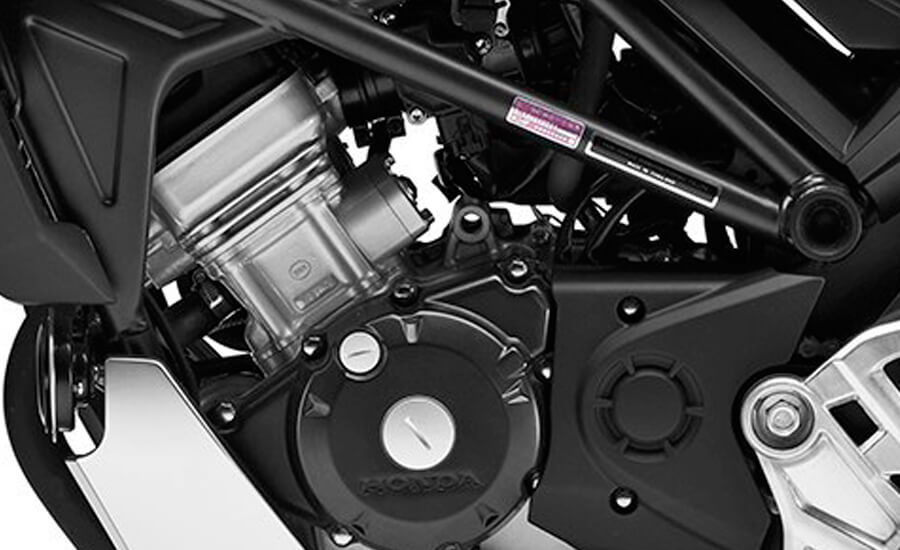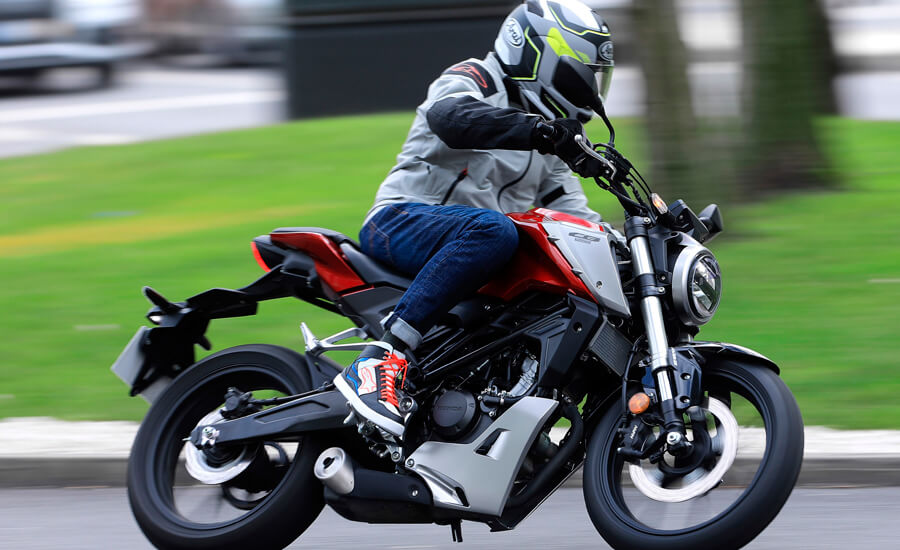Few possessions are as much fun as a motorbike. Knowing the parts of a motorbike engine will make you a safer, more efficient rider amidst any mechanical surprises. Learning about your machine’s engine does not require an in-depth analysis. It will also help you to ride more effectively. And you can lengthen its useful life and check any indications of breakdowns.
Although electric engines for motorbikes are gaining ground among the public’s preferences, it is clear that that the immense majority of current motorbikes still use internal combustion engines.
Now that the era of two-stroke engines is behind us because of their high emissions, we will focus on four-stroke engines.
Let’s consider the example of a four-stroke single cylinder engine on a popular model for beginners—the Honda CB125 R.


General characteristics
The Honda CB125 R uses a four-stroke single cylinder engine with liquid cooling and a six-speed gearbox. If you don’t understand much about mechanics, the last sentence probably sounded Greek to you. But it is very easy to understand.


Engine block
An internal combustion engine uses the energy from the expansion of gases resulting from the ignition of a mixture of air and fuel at the right proportions. For petrol engines, ignition is done with a spark from a spark plug moments before the piston reaches its highest point (TDC or Top Dead Centre). This happens in a space known as the combustion chamber, which is between the piston and the cylinder head. And it happens once for every two rotations of the crankshaft in four-stroke engines.
The piston moves linearly in the cylinder, going up and down between the TDC and the BDC, or Bottom Dead Centre (that distance is the engine’s stroke), and a crankshaft connected to the piston with a connecting rod converting that alternating linear movement into a rotating motion.


Transmission
The engine spins at very high speeds, which means it must be decreased at several stages. The first stage is primary transmission, which connects a small gear connected to the end of the crankshaft with another gear with more teeth.
That larger gear is normally used to operate the bell housing, which connects and disconnects the engine’s rotating transmission with the gearbox, releasing it in specific amounts with the left lever to move the motorbike.
The clutch outlet it is connected to a shaft with the same number of pinions as the motorbike’s gears or speeds—six, in our specific example—and, parallel to this primary shaft, a secondary shaft with the same number of pinions will offer different gearings when shifting.
The selector mechanism controlled with the gear shifter pedal on the left side of the engine will shift to the pinions corresponding to the selected gear.
Lastly, the secondary shaft ends in a (drive) pinion that is connected to a crown gear on the rear wheel connected with a chain or belt drive. This set is the final or secondary transmission.


Fuel supply, ignition and distribution
The fuel reaches the cylinders from a separate tank through pipes that run to the injection system. This system pulverises the fuel over the inlet valve when the valve is open, mixing with the air coming from the filter at an ideal proportion known as the “stoichiometric mixture” (14.7g of air for 1g of fuel).
At the same time, the ignition system creates a spark in the spark plug at the right time (a bit before the piston reaches its TDC in the compression cycle).
For the CB125R, the crankshaft has a single connecting rod anchored to it, with its respective piston at its upper part (or head end).
Distribution is the engine’s mechanism that brings the fresh mixture into the combustion chamber and extracts the burnt gases from it. To do this, it uses inlet and exhaust valves that open and close at the cylinder head.
Synchronisation is done with the crankshaft, generally with a distribution chain connected to one (SOHC) or two camshafts (DOHC). Its purpose is to move rocker arms or push rods, which in turn open the valves pushing them from the bottom and returning them to the closed position with a spring.
Engines can vary in terms of the number of valves they have. According to the desired level of performance and conditions of use, there can be engines with two, three, four, and even five valves per cylinder. In our case, the CB125R has a SOHC engine with two valves, one inlet valve and one exhaust valve.
Combustion in the cylinder repeats dozens of times per second. The terms “engine speed” and “revolutions per minute” will almost certainly sound familiar to you.


Cooling and lubrication
An engine’s activity inevitably results in a high temperature. A large number of engines were cooled by air in the past. This system, despite its mechanical simplicity, offers lower performance.
However, liquid cooling systems use a pump and radiator to maintain a constant flow of coolant around the engine. This helps to keep the engine’s temperature at the ideal point of operation.
If you’re riding your motorbike in the city, there is less cooling of the radiator with normal airflow. To make up for this, a temperature switch activates the electric fan that forces the air past the radiator.
The final crucial component in an engine is the lubrication system. The crankcase is in the lower part of the engine where the oil is stored. The oil is drawn from there with an oil pump, which is sent through a filter into several pipes that go to the different parts of the engine at a specific pressure. After lubricating the internal components, the oil again drips into the crankcase.


A long useful life for your engine
Regardless of your mechanical knowledge, there are several factors that you do have within your reach from the very first day. With them you can ensure your motorbike’s engine has a long and happy life.
In addition to maintenance according to the manufacturer’s instructions, you can also perfect your riding. Try to avoid unnecessarily high engine speeds. Always drive in the right gear, and never push your engine too far. You’ll not only ensure that it’s healthy, but you’ll also save fuel, and your overall experience will be more satisfying. Your wallet will thank you for all of it.


 Join Us
Join Us  Join Us
Join Us 